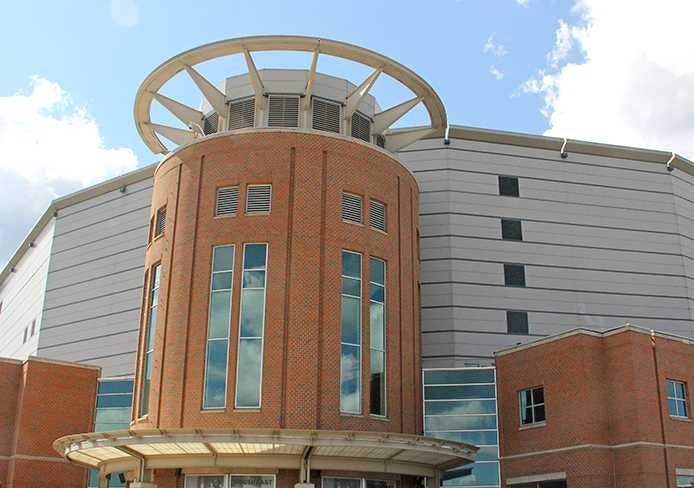
A zero-waste program is set to start at the Schottenstein Center in early January.
Credit: Ritika Shah / Lantern TV News director
Ohio Stadium’s “Zero Waste” initiative is extending to the home of Buckeye basketball.
The President and Provost’s Council on Sustainability recently approved $50,000 in funding to move forward with a zero-waste program at the Schottenstein Center, set to begin in early January, said sustainability coordinator Tony Gillund in an email.
“Funds will be used to purchase recycling bins for the area and establish a system that captures organic materials from the kitchen, suite areas and concession stands,” said Gillund.
These changes will allow the Schottenstein Center to achieve a zero-waste rate of 70 percent at the end of the first year of the program, compared to the rate of 21 percent from Fiscal Year 2014. These funds will cover the cost of education materials, promotional supplies and support the program for the first two years, Gillund said.
“Zero waste” status means 90 percent or more of waste materials are diverted from the landfill through recycling, composting or repurposing, according to the “Zero Waste” initiative website.
OSU launched the “Zero Waste” initiative at Ohio Stadium in 2011 to decrease gameday waste.
The amount of waste produced at home football games is minimized by requiring food vendors to use compostable and recyclable products and eliminating the need for trash cans.
With the help of “Zero Waste” volunteers, the food waste collected from the program is transported to Price Farms Organic, a composting facility in Delaware, Ohio. The waste is composted and eventually turned into a mulch called “Stadium Scarlet,” and is available for purchase, said owner Tom Price.
Stadium Scarlet is $40 per cubic yard, according to the farm’s website.
During the 2014 football season, over 95 percent of the waste produced and collected from Ohio Stadium was diverted from the landfill. All of the food scraps from the stadium’s kitchen and suites are converted into mulch, distributed as Stadium Scarlet, Price said.
“The turn-around time for converting the waste into mulch is about two years,” he said. “In one football season, we will make enough Stadium Scarlet to fill the beds of 75 pick-up trucks. That’s quite a bit.”
Football fans were also encouraged to participate in the Tailgate Recycling Program, which aimed to reduce contamination and streamline the process for Buckeye fans tailgating outside the stadium, Gillund said. During the games all aluminum cans, glass bottles and plastic bottles were placed in provided recycling bins or bags. Volunteers helped fans properly recycle.
“I volunteered at the Ohio State versus Indiana game,” said Hannah Cohan, a fourth-year in psychology, in an email. “I was instructed to inform fans of the location of the bins and encourage people to recycle and compost their waste.”
But it doesn’t stop at sporting events.
OSU is pursuing ways to improve and expand its “Zero Waste” initiative in hopes of meeting the goal to become a completely waste-free campus by 2030.
“The Ohio State University strives to be a leader in global sustainability by demonstrating the integration of sustainable practice and programming across all university functions,” Gillund said. “Waste reduction is at the core of these efforts and the university has set a goal to becoming less wasteful.”
To achieve this goal, the initiative has been introduced at regional OSU campuses to encourage them to work toward reaching zero-waste status.
“The Marion campus is already on the right track,” Gillund said. “The campus has nearly achieved zero-waste status with a diversion rate of 89 percent for the month of November.”
With the expansion of the “Zero Waste” initiative, Price said he looks forward to continuing to work with OSU, and is already monitoring the space he has available for storing all of the waste being collected.
“We absolutely have enough space to continue in the future,” he said. “The amount of space that this compost takes up at Price Farms is fairly small, but it is not insignificant. It is such a unique program and it is neat to say we play a part in what Ohio State is doing.”


